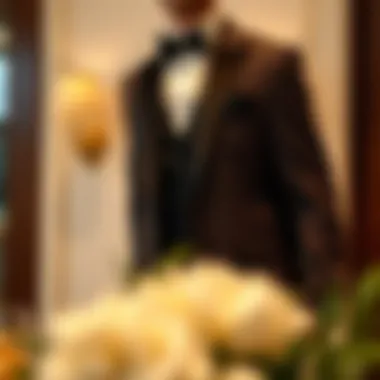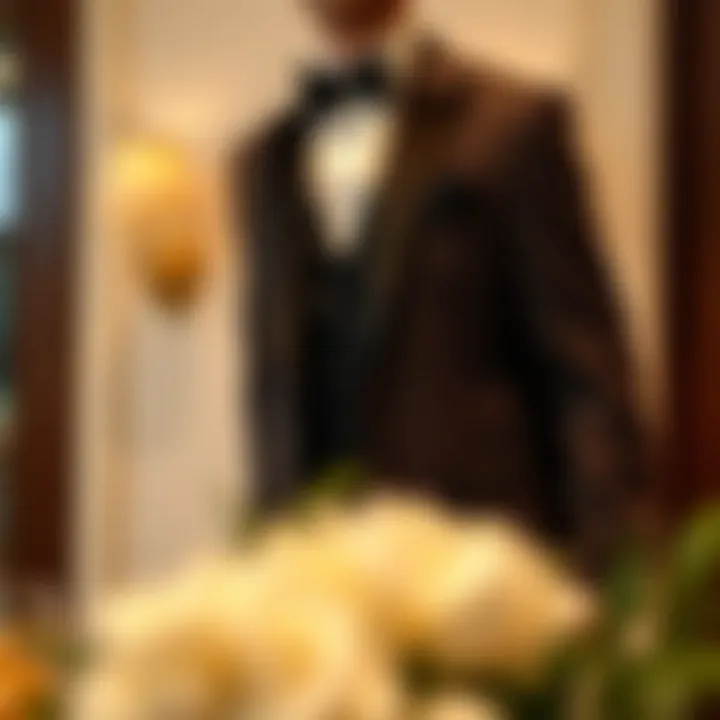Understanding Dress Codes: A Comprehensive Guide


Intro
Navigating the world of dress codes can often feel like learning a complex language, one that governs personal expression in professional environments, social interactions, and cultural settings. The subtle nuances embedded in dress codes extend far beyond mere fabric and fashion choices; they can affect first impressions, influence workplace dynamics, and shape social camaraderie.
In this intricate dance of attire, understanding the essence of different dress codes is crucial. Whether attending a job interview, a wedding, or even a casual gathering, the right outfit can speak volumes about one’s respect for the occasion and the people involved. For instance, donning an elegant suit for a formal event conveys professionalism and seriousness, while casual wear might suggest approachability. However, these codes are not static; they evolve with cultural shifts and market trends.
This guide dives deep into the multifaceted world of dress codes, unpacking their significance across various contexts. By analyzing different styles, including business formal, cocktail attire, and more, readers will arm themselves with essential tools to make informed clothing choices. As we explore these themes, it is important to keep in mind that dressing appropriately is not just about following rules; it's about integrating oneself into social fabrics and acknowledging the underlying messages transmitted through attire.
Understanding dress codes is like learning an art—it's about balance, choice, and a touch of keen observation.
As we venture further, we will discuss the current market trends and how they interplay with dress codes today. This exploration will equip you with a deeper appreciation of the cultural implications surrounding clothing choices, as well as practical strategies to adapt to various settings effectively.
Preface to Dress Codes
Dress codes are often the invisible threads that weave through the fabric of our daily interactions, especially in professional and social environments. They serve not just as guidelines for attire, but also carry substantial weight in how we perceive one another and ourselves. By understanding dress codes, individuals can navigate complex social landscapes with ease and confidence. This guide aims to shed light on the nuances surrounding dress codes, tackling their significance, the rationale behind them, and the evolving nature of what is deemed appropriate attire.
Definition and Purpose
At its core, a dress code is a set of rules governing the attire deemed acceptable for a specific occasion. These codes can range from casually comfortable wear to meticulously formal ensembles. The purpose of a dress code goes beyond just aesthetics; it establishes a sense of cohesion and professionalism within groups, enhancing unity and aligning with organizational culture. For instance, a luxury real estate office may adopt a business formal dress code to project an image of success and sophistication to high-end clientele. Similarly, a tech startup might embrace a casual dress code, signaling its innovative and progressive nature. Understanding the purpose behind various dress codes helps individuals align their personal style with the expectations of their environment.
Historical Context
The evolution of dress codes is deeply rooted in societal norms and cultural shifts. Traditionally, clothing was often dictated by class, profession, and national customs. For instance, during the Victorian era, strict dress codes governed the upper classes, reflecting their status and moral values. A gentleman was expected to don a suit and bowler hat, while women adorned themselves in corsets and elaborate gowns. These norms channeled ideas of respectability and hierarchy.
In more modern times, the rise of casual wear and the breaking down of traditional barriers has led to more fluid interpretations of what constitutes appropriate attire. The 1960s and 70s saw significant cultural revolutions, where personal expression in fashion began to flourish. Icons like Audrey Hepburn and James Dean set new standards, breathing life into informal yet stylish attire. Today, we’re witnessing a continuous negotiation of dress codes across various industries, reflecting a broader acceptance of diversity and self-expression.
In essence, understanding the historical context of dress codes enriches our appreciation of their current applications. It prompts us to question not only the 'what' but also the 'why' behind our clothing choices. As we delve deeper into the nuances of various types of dress codes in this guide, it becomes clear that each code is a reflection of both individual identity and collective societal values.
Types of Dress Codes
Dress codes serve as the unwritten rules that govern how individuals present themselves in various social and professional contexts. Understanding the types of dress codes is crucial, as they often dictate how one is perceived by others, influencing not only first impressions but also ongoing interpersonal dynamics. Here, we explore the different types of dress codes, breaking them down into specific categories that range from casual to formal, along with their unique implications and significance in both personal and professional domains.
Casual
The term "casual" can sometimes feel like an open invitation to wear whatever one fancies but, in reality, it encompasses a range of styles. Casual dress typically refers to comfortable attire that is more relaxed, such as jeans, t-shirts, and sneakers. While this dress code might seem straightforward, context matters immensely.
In the realm of work, for instance, casual attire can still convey professionalism, especially in creative industries or tech environments. Dress-down days or casual Fridays have become commonplace in many companies, providing employees a chance to showcase individuality while maintaining some professional standards. Here are a few examples:
- Weekend Attire: This often includes a mix of jeans, casual tops, and comfortable shoes.
- Home Office Style: Comfortable yet presentable outfits like soft joggers paired with a crisp shirt.
It's vital to strike a balance between comfort and appropriateness, being mindful that casual doesn't equate to sloppy. Observing colleagues can offer guidance on how to navigate this dress code effectively.
Business Casual
Business casual blends elements of traditional business attire with a more relaxed approach. For many professionals, especially those in fields like real estate or finance, this dress code has become a staple of the workplace.
Business casual typically includes dress pants or chinos, paired with collared shirts (like polo or button-downs) for men, and skirts or tailored pants combined with blouses for women. The key is to keep things polished without leaning too far into formal wear. Some important pointers to consider include:
- Footwear: Opt for loafers, ankle boots, or flats instead of sneakers or overly casual shoes.
- Accessories: Subtle jewelry or a smart watch can elevate your look while remaining understated.
Business casual allows for personal expression, enabling individuals to present themselves confidently without the constraints of formal attire. Efforts in this nuance matter, as they often communicate respect and professionalism in a more laid-back way.
Formal
When one hears the word "formal," the mind typically conjures images of elegant suits, posh dresses, and a well-groomed appearance. Formal dress codes can vary significantly based on the occasion—such as a wedding, gala, or professional meeting—but generally demand a high level of sophistication.
For men, this often involves a tailored suit, collared dress shirt, and a tie, while women may opt for dresses, gowns, or dressy suits. The richness of fabrics and the refinement of accessories play a crucial role in achieving this polished look. Important considerations include:
- Color Palette: Dark colors for evening events, lighter tones for daytime engagements.
- Fit: Proper fitting enhances appearance and manifolds confidence.
Formal attire signals respect for the occasion and its significance, making it paramount to adhere to this code when the situation calls for it.
Cocktail
The cocktail dress code sits comfortably between formal and casual—it’s a bridge of elegance. Often seen at social gatherings, cocktail parties, or evening events, this dress code allows for a bit more creativity while still maintaining a certain level of sophistication.
Cocktail attire for women generally includes knee-length dresses or elegant separates, while men are encouraged to wear dark suits with a dress shirt, possibly without a tie. Considerations for this code are:


- Dress Length: For women, opting for dresses that hit just above or below the knee is ideal.
- Footwear Choices: Heels or polished shoes are usually preferred, adding to the overall formality of the outfit.
The cocktail dress code promotes the idea of stylish preparedness—ensuring one feels confident and ready for the evening’s festivities.
Black Tie
Black tie is likely the most rigid and formal of all dress codes. This category is often reserved for upscale events such as galas, formal weddings, and important ceremonies. Adhering to this dress code is crucial as it signifies that an event is of utmost formality and importance.
For men, a black tie entails a tuxedo—typically black, paired with a white dress shirt, black bow tie, and polished dress shoes. Women often wear elegant evening gowns or sophisticated cocktail dresses, sometimes incorporating luxurious fabrics and statement pieces.
When dressing for a black tie event, consider:
- Fabric Choices: Silk and satin lend an air of luxury.
- Accessories: Men may wear cufflinks, while women can opt for finer jewelry that complements their attire.
In this setting, an individual’s attire speaks volumes about their respect for the event and its hosts, making it essential to adhere to the code precisely.
"The way you dress impacts how others perceive you, influencing networking opportunities, increasing confidence, and creating a lasting impression."
Understanding these different types of dress codes not only helps in navigating social norms but also plays a pivotal role in one's professional persona. By selecting the right attire for the occasion, individuals can enhance their credibility and influence while establishing an image aligned with their personal brand.
Cultural Perspectives on Dress
Understanding dress codes transcends fabrics and fits; it taps into the cultural psyche, shaping how individuals present themselves in various social contexts. This section focuses on itnegrating cultural perspectives on dress as a vital lens through which we can interpret the significance of attire in both daily interactions and professional environments.
Western Cultures
In Western cultures, attire often reflects personal choice and individuality. From the casual vibes of Californian beachgoers to the tailored suits of Wall Street, clothing choices can indicate not just personal taste but also socio-economic status. However, the importance of dress codes can sometimes lead to misunderstanding. For instance, in certain corporate settings, what may seem like a casual approach might be viewed as a lack of professionalism. Hence, understanding the unspoken rules of dress within these cultures is crucial for expatriates or those looking to establish a foothold in such environments.
- Traditional Attire: In some areas, specific attires resonate with historical or cultural significance. For instance, the Scottish kilt represents a deep-rooted tradition, while American workwear varies widely from tech hubs to traditional sectors.
- Subcultures and Trends: Fashion movements also play a significant role. Streetwear, for example, has infiltrated mainstream fashion, creating a blend of casualness with high fashion, whereas other periods prioritized formal wear. The nuance here is how adaptability signifies a person’s intellect and social sorting.
Eastern Cultures
Eastern cultures offer a contrasting narrative; attire is often more rigidly defined by customs and traditions. In contrast to the focus on individual expression in the West, many Eastern societies place a substantial emphasis on conformity to traditional norms.
Here are some considerations:
- Symbolism: Dress often symbolizes status and expectations. For instance, in Japan, Kimono fabrics signify various life stages or events, while in India, a Saree or Kurta can display cultural pride and identity.
- Business Attire: In countries like China and India, office attire typically aligns with conservative styles. Suits speak volumes of professionalism but require cultural finesse in color and pattern; darker colors may signify respect while white can be associated with mourning.
- Religious Considerations: The attire is usually influenced by religious expectations as well. For instance, some Muslim women wear Hijabs or Abayas, signifying cultural identity. Understandings surrounding modesty affect social perceptions significantly.
Global Influence of Fashion
As the world becomes more interconnected, the influence of global fashion trends has transformed traditional notions of dress. A singular style or trend can ripple across continents, creating a blend of cultural expressions and expectations.
- Fusion of Styles: Street fashion from Tokyo might find its way to Paris catwalks; the global exchange fuels creativity and diversification in how we perceive dress codes. This fusion pushes individuals to adopt cross-cultural elements while fostering uniqueness.
- Sustainable Fashion: Global dialogues around sustainability and ethical fashion are also crucial. The rise of eco-friendly brands highlights the importance of making conscious choices, affecting dress codes in various sectors. With more awareness, consumers are more inclined to choose brands that reflect their values, thus ending dress codes reliant solely on aesthetics.
- Technology and Social Media: The advent of social media has eroded geographical boundaries, where trends can go viral overnight. Platforms like Instagram and TikTok have democratized style, allowing individuals to interpret and apply these trends according to their cultural backgrounds. And these influences can have a profound impact on local dress codes, as seen in the popularity of athleisure wear that embodies comfort while retaining a polished appearance.
The Role of Dress Codes in Professional Settings
Dress codes serve as unspoken rules that help set the tone for professionalism in various work environments. In today’s fast-paced world, understanding the nuances of attire in professional settings is paramount. It goes beyond mere fabric and seams; it speaks to how individuals want to present themselves and how they are perceived by others. In a competitive landscape, a well-thought-out dress code can foster a positive atmosphere and promote a company’s values.
Corporate Environment
In the corporate arena, dress codes are often more structured and serve distinct purposes. A formal attire typically instills a sense of respect and seriousness. Think about an investment bank or a law firm where every tie and blazer symbolizes professionalism. It’s not just about looking sharp; it’s about establishing credibility among clients and colleagues.
- First Impressions Matter: When you walk into an important meeting dressed appropriately, it sends a signal that you take the business seriously. Research has shown that well-dressed individuals are perceived as more competent and trustworthy.
- Fostering Company Culture: A clearly defined corporate dress code can bolster an organization’s culture. For instance, firms that encourage business casual may embrace creativity and innovation, reflecting their core values.
- Equality and Uniformity: Having a standard dress code can level the playing field. Employees from diverse backgrounds can feel included when the focus shifts away from personal style to a uniform standard.
Creative Industries
While you may expect an artist or graphic designer to wear whatever they please, even creative industries have their own kind of dress code. It's more fluid but still packed with meaning!
- Self-Expression: In creative fields, attire can be an extension of one's artistic vision. Designers and marketers often utilize fashion to communicate their personalities and ideas. Unique styles can be the hook that attracts clients and collaborations.
- Flexibility & Trends: Professionals in creative sectors tend to enjoy more liberal dress codes, allowing them to showcase individuality. However, understanding the prevailing trends is crucial. While one might don a bold outfit, another may be mistaken as too casual or reckless if they miss the mark.
- Client Interaction: When meeting clients or stakeholders, it’s prudent to gauge the expected dressing norms. An art director might wear jeans and sneakers to their studio yet choose a more polished look for an important presentation.
Startups vs. Established Companies
Not all workplaces are created equal, especially when it comes to dress codes. Startups and established companies often differ vastly in their approach, reflecting broader company philosophies and attitudes.
- Startups: They often embrace casual attire and prioritize comfort over formality. This can encourage a relaxed atmosphere that fosters creativity. The prevailing mantra might be: “Dress for the job you want, not the job you have.” The expectation is for employees to feel comfortable while maintaining a basic level of professionalism.
- Established Companies: These organizations frequently uphold traditional dress codes to maintain their legacy and brand reputation. Employees might be required to adhere to business formal or business casual attire, reinforcing established norms and practices.
- Balancing Act: Startups sometimes experience pressures to “professionalize” as they grow. This transition requires sensitive handling of dress codes, as enforcing stricter rules can clash with the laid-back culture that thrived in their earlier days.
Having a clear understanding of how dress codes operate in different professional settings enables you to navigate them effectively. These guidelines influence not only how we perceive each other but also how we are perceived. They form an essential part of workplace identity, shaping behaviors and attitudes across the board, be it in a formal boardroom or a trendy studio space.
Understanding your environment and adapting accordingly can illuminate the path to success in your professional journey.


For further reading on how dress codes can affect workplace dynamics, visit Wikipedia or explore resources at Britannica for a broader context.
Impacts of Dress Codes on Individual Identity
The notion of dress codes transcends mere fabric and threads. It delves deep into how we perceive ourselves and how the world perceives us. Understanding the impacts of dress codes on individual identity is paramount in today’s fast-paced, visually oriented society. A carefully chosen outfit can symbolize empowerment, creativity, or conformity, while also being a beacon for social judgment.
Self-Expression
Dress is one of the most immediate forms of self-expression. When individuals choose their attire, whether it be through vibrant colors, bold patterns, or modest garments, they begin to tell a story about who they are. For instance, an artist might don oversized clothing splashed with paint, conveying creativity and a touch of rebellion against traditional norms. Conversely, a lawyer might opt for tailored suits, embodying professionalism and authority. The choice of clothing unveils elements of personality, cultural background, or even political beliefs.
The flexibility in dress codes can foster a sense of belonging or, in some cases, ostracism. In environments with strict regulations, such as many corporate offices, individuals may feel restricted and unable to reflect their true selves. Thus, while dress codes can promote a level of professionalism, they inadvertently complicate personal expression.
Conformity and Individuality
Every society has norms, and dress codes are often its visual representation. These guidelines may promote conformity, which can be both uplifting and stifling. On one hand, adhering to a dress code can create a sense of unity and reduce social anxiety. Imagine a team of sports professionals; their uniforms create a unified image that fosters team spirit. However, it also raises questions about individuality. When everyone dresses alike, where does uniqueness fit?
Individuals may grapple with balancing their desire to conform with their innate need for individuality. Some express their distinctiveness through minor deviations from the expected attire. For instance, a professional might wear colorful socks beneath an otherwise standard gray suit. These small choices can serve as silent yet powerful statements, subtly challenging the boundaries set by dress codes while still adhering to them.
Psychological Aspects
The psychological implications of dress codes are profound. Studies have shown that what we wear can influence our mood, confidence, and overall mindset. Dressing for success is not just a cliché; it’s a timed truth. When individuals dress in a way that aligns with their personal or professional aspirations, they often feel empowered. This psycholigical boost can enhance performance and instill a sense of readiness.
However, pressure to meet certain expectations can lead to feelings of inadequacy or anxiety. Individuals may find themselves grappling with the need to meticulously curate their appearance to fit specific dress codes. This constant battle can take a toll on mental well-being.
"Clothes mean nothing until someone lives in them." – Marc Jacobs
Exploring how dress codes affect individual identity sheds light on the intricate interplay between clothing, self-perception, and societal expectations. In a world where first impressions can be make or break, understanding these dynamics becomes essential. By navigating dress codes effectively, individuals can harness their attire to bolster both personal confidence and professional success.
Dress Codes and First Impressions
Understanding how dress codes impact first impressions can't be overstated. The way someone presents themselves through attire often sets the stage for how they are perceived in various social and professional interactions. In many cases, a well-chosen outfit can speak volumes, indicating a sense of respect, professionalism, or cultural awareness. However, getting it wrong can lead to misunderstandings or missed opportunities.
A notable element is the psychological impact of how attire affects both the wearer and the observer. Items of clothing can signal belonging to a group or status within a hierarchy. This observation is quite notable in social settings; individuals dressed in a similar manner are often more likely to bond, creating a comfortable environment conducive to conversation.
Social Settings
When it comes to social gatherings, the attire one chooses can serve as a bridge or a barrier. For example, imagine walking into a wedding where everyone is clad in chic dresses and tailored suits, and you're in a casual outfit. The discrepancy can form an invisible wall, leaving one feeling out of place. Social etiquette often dictates that certain dress expectations are in place, which provide not only guidelines but also assurances that guests are adhering to the norms of the event.
Being attuned to the dress code signals a level of social intelligence and respect for the hosts. It says, "I recognize and appreciate the effort you've put into organizing this gathering." This understanding may seem trivial, but it holds significant weight. People often judge based on appearance, making it essential to align your outfit with anticipated standards.
- Casual Gathering: Opting for smart-casual attire sends the right message—easygoing yet thoughtful.
- Formal Events: A well-fitted suit or an elegant dress adheres to norms while still allowing for personal expression.
- Cultural Events: Embracing clothing that reflects cultural roots, whether through patterns or traditional attire, can evoke feelings of pride and respect.
Such considerations play a vital role in creating memory anchors in social interactions, where a positive experience encourages stronger relationships.
Professional Settings
In professional environments, the pressure of first impressions intensifies. From interviews to business meetings, attire directly influences perceptions of competence and authority. Often, individuals seeking employment may overthink their wardrobe choices, worrying about appearing too formal or too relaxed, both of which can change how they are evaluated.
Incorporating a better grasp of the dress code can make all the difference. For instance, a candidate wearing a tailored suit to an interview at a marketing agency may seem out of touch, whereas a smart casual outfit may resonate better with the company culture.
Some key points for professionals to consider:
- Corporate Interviews: Always lean towards formal unless specified otherwise; it emphasizes seriousness about the role.
- Casual Fridays: These days allow for relaxation in attire, yet a business-casual approach is still advisable to maintain professionalism.
- Networking Events: Here, engaging attire that sparks a conversation can be beneficial, such as a unique accessory or stylish shoes that lend personality without overwhelming.
By keeping these aspects in mind, one can navigate the complexities of professional dress codes effectively, making a strong first impression that reflects both competence and potential, paving the way for future opportunities.
In both personal and professional arenas, the way you dress can create lasting impressions and open doors, or close them just as quickly.
Ultimately, whether in social or professional contexts, awareness of dress codes is not just about conformity; it's about leveraging attire to communicate effectively, share respect, and evoke belonging. The result is a symbiotic relationship between how you wish to be seen and how quickly you can integrate into any gathering.
Adapting to Dress Codes
Navigating dress codes can be trickier than one might think. Whether you're attending a business meeting, a wedding, or a casual outing with friends, understanding how to adapt your attire accordingly is crucial. This section delves into the importance of adapting to dress codes effectively and offers practical advice on how to do so.
Decoding Dress Code Instructions
When you receive an invitation or a notice about a dress code, it's essential to decode the instructions clearly. Here’s how to do it:


- Identify Key Terms: Common phrases can often hint at what to wear. For instance, "smart casual" signals a balance between comfort and style, while "business formal" suggests a more polished look.
- Consider the Occasion: The context matters greatly. An annual corporate gala will likely require a different ensemble compared to a casual Friday at the office. Think not just about the dress code but the nature of the event.
- Look for Visuals: Many times, the host may provide imagery or links to websites giving examples of the appropriate attire. Browsing through these examples can be immensely helpful.
- Consult Trusted Sources: If you're still in doubt, refer to fashion blogs or specialized websites. Resources such as Wikipedia can offer detailed descriptions of various dress codes.
"Understanding the specifics of dress code instructions allows for a more confident appearance and eliminates uncertainty."
Choosing the Appropriate Attire
Once the dress code is decoded, the next step is to choose the right outfit. This process should take into account personal style, comfort, and appropriateness. Here are some tips:
- Match Attire with Personal Style: It's essential that your outfit reflects who you are. Certain elements can be tailored; for example, if the code calls for business casual, adding a personal touch such as a vibrant tie or a stylish scarf can inject personality without crossing boundaries.
- Mind the Climate and Venue: The setting and weather need to be taken into account as well. An outdoor summer wedding might permit lighter fabrics, while a winter function may necessitate layers.
- Evaluate Fit and Comfort: Garments that are well-fitted can enhance confidence. Make sure whatever you wear feels right. Uncomfortable attire can lead to distractions during the event.
- Quality over Quantity: Invest in versatile pieces that can serve multiple purposes. A classic blazer, for instance, can seamlessly transition from a workplace setting to a casual dinner.
By understanding how to effectively adapt to dress codes, one can not only navigate social and professional landscapes with ease but also convey the right impression. This ensures that attire remains a reflection of both respect for the occasion and a personal touch.
Challenges in Following Dress Codes
Navigating the intricate world of dress codes can often feel like walking a tightrope. For both seasoned professionals and newcomers alike, the challenges that arise when trying to adhere to specific dress standards can vary significantly. Understanding these hurdles is crucial because they can impact one's professional image, job performance, and even interpersonal relationships. Here, we will delve into the complexities of dress code compliance, focusing on two main areas: confusion and misinterpretation, along with cultural barriers.
Confusion and Misinterpretation
Dress codes, much like instructions for assembling furniture, can sometimes be cryptic. The nuances of what is deemed "business casual" versus "cocktail attire" can lead to a whirlwind of misinterpretations. For instance, while a polo and dress slacks may fit the bill for one office environment, another might expect a button-up and tailored trousers. This confusion not only leaves individuals feeling insecure about their choices but can also result in awkward situations.
"The first step to overcoming confusion in dress codes is understanding the expectations."
When it comes to formal events, a common scenario is when guests arrive thinking that a "cocktail" dress code allows for a more relaxed interpretation, only to find themselves underdressed compared to others in the room, perhaps adorned in elegant cocktail dresses or sharp suits. To combat this, consider asking for clarification if the dress code is vague.
Cultural Barriers
Dress codes can also be influenced by cultural expectations, adding another layer of complexity. Different cultures have their unique styles, and the interpretation of attire can drastically vary from one region to another. A simple t-shirt and jeans might be perfectly acceptable at a gathering in the United States, while in other countries, the same outfit could be seen as disrespectful or too casual.
For expatriates or those attending international events, understanding local customs can be crucial. Imagine an investor attending a business meeting in Japan; standard formal wear in the West might not suffice if the expectation remains for more traditional attire.
To bridge these cultural gaps, research is essential. Exploring resources like Britannica or Wikipedia can provide insight into cultural dress norms. Furthermore, local contacts or colleagues can serve as valuable guides in determining what is appropriate.
By being aware of the challenges tied to dress codes and actively seeking solutions, individuals can not only enhance their professional image but also navigate the social landscapes of diverse environments with greater ease.
Future Trends in Dress Codes
As society evolves, so do our perceptions of dress codes. It's essential to consider how shifts in style, culture, and environmental awareness interweave to create a new tapestry of dress norms. This section explores two pivotal trends that are reshaping how we view clothing in both personal and professional contexts: the casualization of styles and the urgent call for sustainability and ethical fashion.
Casualization of Styles
Casual wear has gradually become a mainstay across various settings. Gone are the days when tailored suits were the only acceptable attire for boardrooms or high-stakes meetings. Instead, we see a growing acceptance of relaxed yet polished outfits that allow individuals to express their personality while maintaining professionalism. This trend reflects not just a shift in fashion, but also a deeper societal change that champions comfort and authenticity.
- Evolution in Work Attire: With the rise of remote work and hybrid models, there's a significant impact on how employees present themselves. A crisp pair of jeans and a smart blazer can replace a traditional suit, maintaining professionalism while allowing for comfort.
- Cultural Shifts: The blending of workplace norms with casual culture can be traced back to industries that have long embraced informalwear—like tech and creative fields. This blending signifies a major cultural shift, one that favors flexibility and self-expression over rigid norms.
- Implications for Businesses: For homeowners and investors in the real estate sector, adapting to these trends may necessitate adjustments in client relations. Not understanding the evolving dress code can hinder the ability to connect with clients or adapt to market needs.
This casual approach provides a refreshing break from the stiff rigidity of past dress codes, yet it comes with its own set of challenges. Balancing comfort with appropriateness in formal circumstances requires a discerning eye and a solid grasp of the context.
Sustainability and Ethical Fashion
In today’s environment, sustainability isn't just a buzzword—it's a necessary pivot. The fashion industry is pivotal in dieser conversation, bringing attention to the consequences of fast fashion and its impact on our planet. Here's how this concept is manifesting within dress codes:
- Eco-Friendly Objectives: Consumers are becoming more aware of how clothes impact environmental sustainability. This awareness fuels the demand for ethically sourced materials and transparent production processes. Buyers are increasingly willing to invest in high-quality garments that last longer, rather than mass-produced items that frequently end up in landfills.
- Cultural Responsibility: There's a growing expectation for brands and fashion houses to wear their ethics on their sleeve. This willingness to embrace ethical manufacturing doesn’t just satisfy conscientious consumers but also supports artisans and small-scale producers across the globe.
- Real Estate Sector Consideration: For real estate agencies and developers, marketing spaces as environmentally conscious can resonate well with today's clientele. Buyers, whether expatriates or homeowners, express a preference for locations that promote and support sustainable practices.
The call for sustainability is shaping future dress codes, pushing individuals to rethink their purchasing habits while reflecting their values through their attire. Consumers are looking for authenticity both in the choices they make and from the brands they support.
"The clothes we wear are often a reflection of the values we hold; sustainability is no longer optional but a necessity in conveying those values."
Closure
The conclusion of this article is not merely a summary but an essential piece that stitches together the intricate threads of all the discussions surrounding dress codes. Understanding dress codes is paramount to both personal and professional satisfaction. It allows individuals to present their best selves, foster positive impressions, and adapt seamlessly to various environments.
Summarizing the Importance of Dress Codes
Dress codes serve as the silent signals of our environments. They guide individuals on how to dress appropriately for different contexts, affecting perceptions and interactions. For real estate agents and investors, understanding these codes can directly impact their relationships and negotiations; a well-dressed realtor might evoke trust and professionalism, making clients more willing to engage.
- Establishing a positive first impression
- Fostering respect among peers
- Enhancing professionalism in varied settings
In a world where first impressions are often made within the first few seconds, the significance of a suitable attire cannot be overstated. Not only does it reflect an individual’s respect for themselves, but it also speaks volumes about their regard for others and their environment. The subtle nuances of dressing right can significantly influence social dynamics and perceptions.
Final Thoughts on Navigating Dress Codes
Navigating dress codes can be daunting, especially in multicultural settings where standards may differ. A clear understanding of what is expected can alleviate stress and uncertainty. Here are a few key considerations when trying to identify what to wear in various situations:
- Know Your Audience
Understand the people you will be interacting with and the norms they adhere to. For instance, real estate events might require more professional attire compared to casual community gatherings. - Adaptation
It is crucial to read the room and adapt stylishly without compromising one's integrity. If unsure, err on the side of formality, as it's often easier to scale back than to dress up after the fact. - Stay Informed
Keeping abreast of the latest trends can be beneficial. There are tons of resources anywhere from fashion blogs to local advice, which can illuminate the nuanced differences between various dress codes. Websites such as reddit.com offer forums where individuals share experiences and tips on dress code expectations.
Navigating dress codes can be a delicate dance, but mastering it can prove to be a powerful tool in one's personal and professional life. A thoughtful approach to dressing not only enhances one’s confidence but firmly establishes their identity within social constructs. Ultimately, understanding dress codes is about respect—respect for oneself and the contexts we engage in. That’s where the real magic happens.











